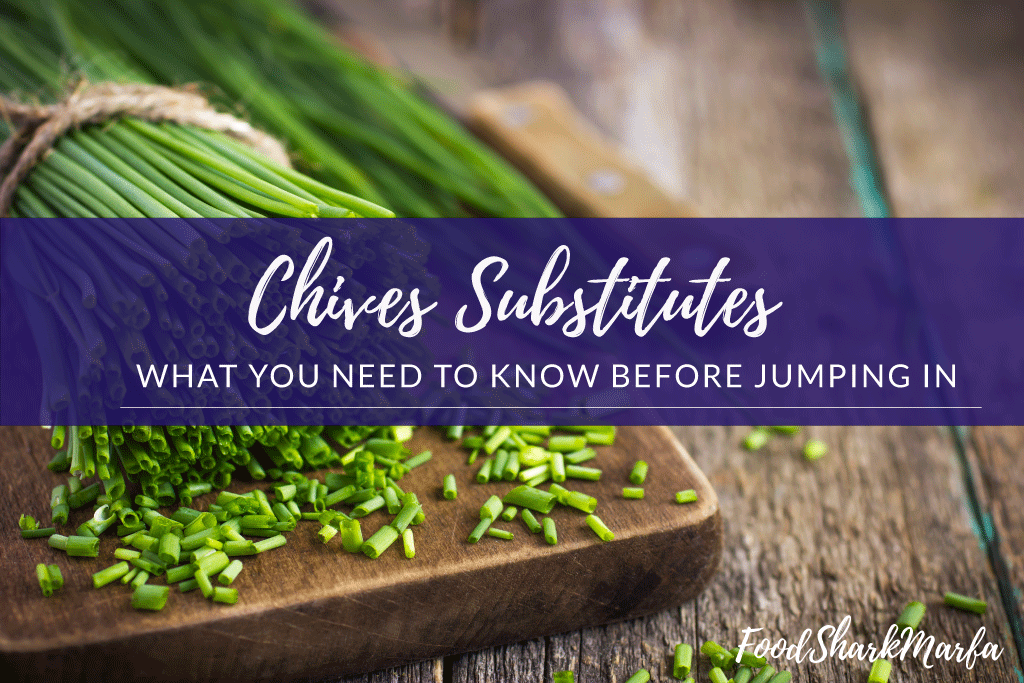Chives are a member of the onion family and are used as an herb, just like oregano or rosemary. These herbs have a long green stem that is hollow on the inside and they are typically eaten fresh. Chives have a somewhat oniony taste but are milder than scallions and not as intensely scented as traditional onions. If you run into a situation where you need the same flavor and texture of chives but don’t have any at hand, choosing one of these chive substitutes will give you just what you need to perfect your recipe without the real thing.
What are chives?
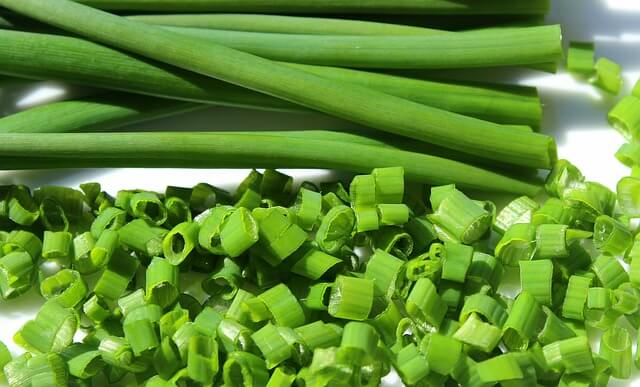
How healthy (or unhealthy) is it?
There are many beneficial nutrients to be found in chives, and they also happen to be extremely low in calories. However, since most people use smaller servings of chives, the nutritional benefits may be minimal. As you can see in the nutritional breakdown, these herbs have little fat or carbohydrates but contain many vitamins, minerals, and other nutrients. Chives also offer choline, which helps with memory, mood, muscle control, and other functions of the brain and nervous system.
Nutritional Breakdown
Chives | Amount (per 100 g) | % Recommended daily intake |
Calories | 30 kcal | 1% |
Total fat | 0.7 g | 1% |
Saturated fat | 0.2 g | 2% |
Carbohydrates | 4 g | 1% |
Cholesterol | 0 mg | 0% |
Salt | 3 mg | 0.2% |
Protein | 3 g | 6% |
Calcium | 92 mg | 9% |
Vitamin B-12 | 0 ug | 0% |
Potassium | 296 mg | 7% |
What recipes use chives?
Chives are very versatile and can be used in many recipes. The entire plant is edible and can be used raw, frozen, or dried. Because they offer a mild flavor, they are often utilized in dishes like mashed potatoes, seafood dishes, soups, omelets, baked potatoes, and dips. The best way to ensure you get the full flavor effect is to chop, snip, or slice them before you use them in a recipe. They can be stored in a bag or container in the refrigerator for about a week for later use.
Why do we need chive substitutes?
While herbs like chives can often be found in the produce section of your local grocery store, that doesn't mean that you will never run out. If you need a quick and convenient substitute for chives, you may very well already have one at hand in your kitchen. There also may come a time when you simply want to switch things up and are curious about what chive substitute would work best for a particular recipe. Thankfully, there are quite a few that offer similar texture and flavor profiles to recreate the effect of chives even without the real thing.
Note:
🌱 = vegan
1. Scallions🌱
Best for: soups, noodles, dumplings, baked goods, and dips.
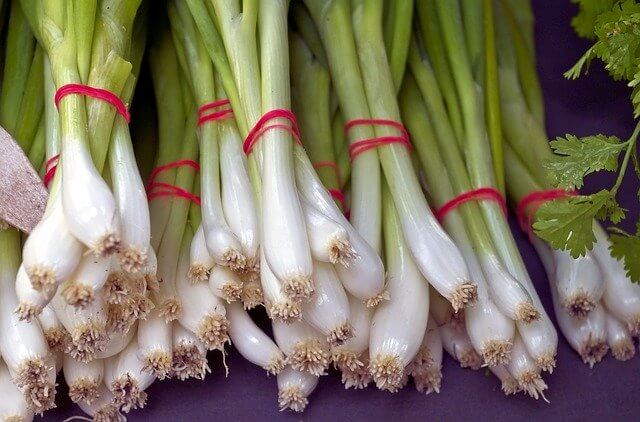
Overview
Scallions are a type of onion, also called spring onions or green onions, that are younger than typical onions. These vegetables have a white base that isn’t a full bulb along with stalks that look very much like the ones on chives. You can use the green and white parts of scallions either raw or cooked. Scallions grow in clumps and have dark green leaves. They are most commonly seen in the spring and summer, when they are often sold in bundles at the supermarket.
Advantages
Some would say that scallions are the ultimate chive substitute since they have that same oniony yet mild flavor. They are also green like chives, so they can offer the same visual appeal when used as a garnish. One of the things that scallions do even better than chives is holding heat, which means you can add them to a dish earlier and get the ball rolling. When using them instead of chives, it’s best to halve the amount to achieve a more similar flavor.
Disadvantages
While scallions are mild, they can have a strong onion flavor, which may not be appreciated by everyone. They also need to be prepared in most cases before being added to a recipe. While whole scallion leaves can be used as a garnish, this is relatively uncommon. However, all you need to do is a little bit of chopping to take your dish to a whole new level.
Nutritional breakdown
Scallions | Amount (per 100 g) | % Recommended daily intake |
Calories | 32 kcal | 2% |
Total fat | 0.2 g | 0.3% |
Saturated fat | 0 g | 0% |
Carbohydrates | 7 g | 3% |
Cholesterol | 0 mg | 0% |
Salt | 16 mg | 0.8% |
Protein | 2 g | 4% |
Calcium | 72 mg | 7% |
Vitamin B-12 | 0 ug | 0% |
Potassium | 276 mg | 7% |
2. Leeks 🌱
Best for: stir-fries, vegetable dishes, pasta, soup, and poultry.
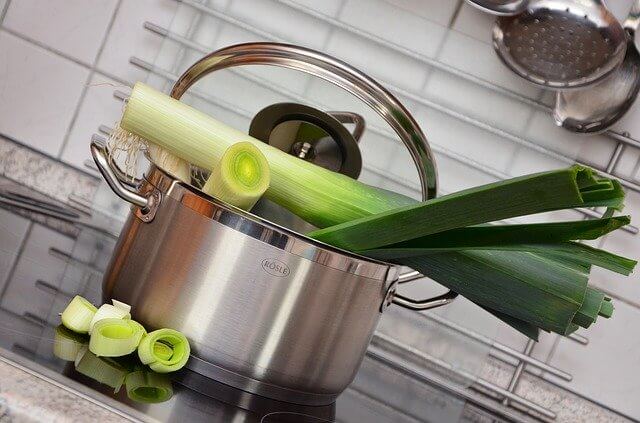
Overview
Leeks are another vegetable that fall into the onion family and are typically produced in Belgium, Turkey, Korea, and France. This herb looks similar to scallions except that they can grow to be much bigger. The vegetable has white flesh and a leafy green top, but the bulb is smaller than you might expect. An easy way to tell how old leeks are is by looking at the bulb. If it's very round, it's older than bulbs that are only slightly rounded.
Advantages
Leeks work as a chive substitute because they offer a mild flavor and need little preparation to use. They can be added into poultry recipes as well as casseroles, soups, and stir-fries. You'll find the freshest leeks in the autumn season through to spring, so there’s a large window of opportunity for making the most of them. These vegetables can be prepared in several ways, including braising, frying, boiling, and roasting. They can also be sautéed in butter and oil like onions for caramelization.
Disadvantages
One of the flavors you’ll find in leeks but not chives is pepper. When cooked, this gives it an overall sweeter flavor, which you may not want in your dish. Before using this vegetable, you will also need to do some extra preparation, such as soaking them in water for at least an hour prior to using them. This cuts down on the strong flavor and will make them taste more similar to chives and other milder onions.
Nutritional breakdown
Leeks | Amount (per 100 g) | % Recommended daily intake |
Calories | 61 kcal | 3% |
Total fat | 0.3 g | 0.5% |
Saturated fat | 0 g | 0% |
Carbohydrates | 14 g | 5% |
Cholesterol | 0 mg | 0% |
Salt | 20 mg | 1% |
Protein | 2 g | 4% |
Calcium | 59 mg | 6% |
Vitamin B-12 | 0 ug | 0% |
Potassium | 180 mg | 4% |
3. Shallots 🌱
Best for: sautés, soups, casseroles, stir-fries, and pasta.
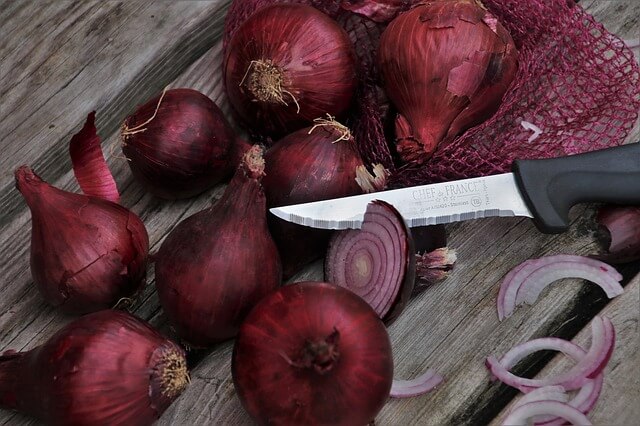
Overview
Shallots are another vegetable from the onion family, just like garlic, leeks, and scallions. Unlike yellow onions, shallots have a sweeter and more delicate flavor that features only a touch of sharpness. This is why they can be substituted for onions just as they can for chives. When you’re at the market picking out shallots, the best options will be firm and have dry skin. You’ll also find they feel heavier than they should for their size. Take care to avoid purchasing shallots with soft spots or those that have already sprouted.
Advantages
With the mild flavor of a shallot, they work well in many recipes and are especially useful for making sauces. They can also be used as a topping or garnish for many vegetables, just like chives. They can also be used whole when roasting with a chicken, cut into rings for a pickled garnish, or even diced to make sauces and salad dressing. This is a versatile option that offers plenty of nutrients.
Disadvantages
If you choose shallots as a chive substitute, keep in mind that they have a peppery flavor like an onion. This may mean you want to use less of them than you would chives. Also, large amounts of shallots can cause negative effects for those with pancreas issues and may cause constipation for some people. If you're someone with gastrointestinal tract problems, you might want to try out a different chive substitute.
Nutritional breakdown
Shallots | Amount (per 100 g) | % Recommended daily intake |
Calories | 72 kcal | 3% |
Total fat | 0.1 g | 0.2% |
Saturated fat | 0 g | 0% |
Carbohydrates | 17 g | 6% |
Cholesterol | 0 mg | 0% |
Salt | 12 mg | 0.6% |
Protein | 3 g | 6% |
Calcium | 37 mg | 4% |
Vitamin B-12 | 0 ug | 0% |
Potassium | 334 mg | 8% |
4. Onions 🌱
Best for: dips, garnishes, sandwiches, salads, and tacos.
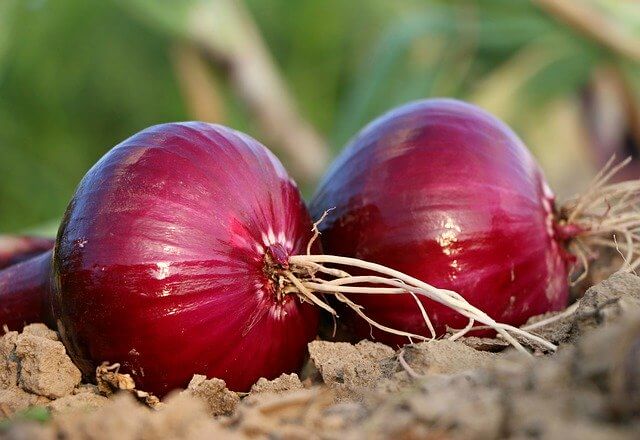
Overview
As we’ve talked about with other substitutes, many of the options on our list come from the onion family, so you probably won’t be too surprised to see onions themselves making an appearance here. Both and onions and chives have the same oniony taste, although at different levels. Onions can also come in various colors, sizes, shapes and a range of flavors depending on the type of onion that you choose. Some are spicy, others are sweet, and some are sharper than others.
Advantages
There are several benefits of using onions when it comes to your health. For example, they can help maintain hair and skin health, reduce the risk of some types of cancer, and improve your mood. A cup of chopped onions can offer 13% of your daily intake of vitamin C, along with other minerals, antioxidants, and vitamins. Two of the most prevalent include manganese and vitamin B-6.
Disadvantages
Onions have a much more robust flavor than chives, so it's important to be aware of how much you use at any one time. That means you can't use as much onion in a dish as you would chives unless you prefer a powerful onion flavor. As an example, a recipe that calls for six tablespoons of chives would only merit two tablespoons of chopped onion for the same level of intensity.
Nutritional breakdown
Onions | Amount (per 100 g) | % Recommended daily intake |
Calories | 40 kcal | 2% |
Total fat | 0.1 g | 0.2% |
Saturated fat | 0 g | 0% |
Carbohydrates | 9 g | 3% |
Cholesterol | 0 mg | 0% |
Salt | 4 mg | 0.2% |
Protein | 1 g | 2% |
Calcium | 23 mg | 2% |
Vitamin B-12 | 0 ug | 0% |
Potassium | 146 mg | 4% |
5. Garlic 🌱
Best for: fish, vegetables, sauces, pasta, and pizza.
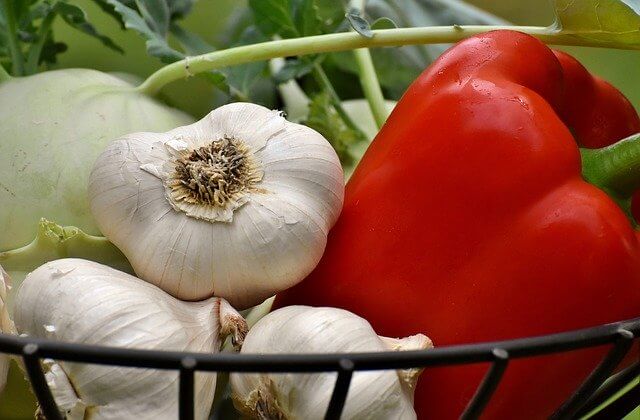
Overview
Garlic is another chive substitute that you may already have around the house. Fresh garlic will come as a bunch of cloves that must be peeled before use if you don’t buy them pre-sliced or minced. Garlic doesn't have the same oniony flavor as cloves, but it does have a taste that many people enjoy just as much or even more.
Advantages
One of the things that sets garlic apart is that it comes in several forms, such as crushed or chopped. Depending on the recipe you are making, one or the other might be the better choice for your dish. This means that garlic is a highly versatile option for recipes compared to some of the other alternatives on the list. If you want a stronger garlic flavor, crushing or mincing garlic is a good option, while chopped garlic gives off a slightly less intense flavor.
Disadvantages
With a clove of garlic, you’re going to have to do some preparation work unless you go for convenient options such as garlic powder or jarred minced garlic. Some people struggle with mincing garlic by hand, which can also make it a struggle if you don't have a garlic press you can use. Add this to the fact that garlic doesn't really taste like chives, and you can see that this isn't going to be the right substitution for everyone.
Nutritional breakdown
Garlic | Amount (per 100 g) | % Recommended daily intake |
Calories | 213 kcal | 10% |
Total fat | 14 g | 17% |
Saturated fat | 0 g | 0% |
Protein | 0 g | 0% |
Salt | 0 g | 0% |
Carbohydrates | 21 g | 0% |
Fiber | 0 g | 0% |
Calcium | 0 mg | 0% |
Iron | 0 mg | 0% |
Vitamin C | 42 mg | 54% |
The Bottom Line
Chives are a delicious herb that can be used in dishes as a garnish or as a main ingredient, depending on what you are cooking. This herb is in the same family as many onion substitutes such as shallots, scallions, and more. Chives are a great thing to have in the kitchen to add a dose of flavor to dishes ranging from cream cheese to salads. If you run out, however, there are several substitutes that you can use in their place. Let’s close off by taking a look at some of the best for each category.
Top vegan picks
All of the substitutes, as well as chives themselves, are vegan, so you have many options here. It is simply a matter of flavor preference and the flavor profile of the dish you’re making that will determine which one you should go for. However, scallions probably offer the most genuine flavor and come in a form that can be used the same way as chives. Onions can also be used as a vegan substitute if you want a stronger flavor.
Top healthy picks
Each of the substitutes on this list have a host of nutrients that are essential components of a healthy diet. Leeks are an excellent low-calorie choice that contains a large number of nutrients like potassium and calcium. Garlic is also low in fat and offers a decent amount of vitamin C. However, none of the substitutes are unhealthy and, when used in small amounts, won’t have much impact on the healthiness of your recipe.
Top convenient picks
It’s hard to pin down the most convenient option compared to chives, as nearly all of the substitutes require some dicing and chopping to get them going. As far as acquiring the ingredients, some of the items you can expect to find at your local grocery store are scallions, onions, and garlic. Most places will also have leeks and shallots, but some may not, making them a bit less convenient than other choices.
Top convincing picks
The number one chive substitute when it comes to offering a similar texture and flavor is the scallion. It provides a very similar look, has the same flavor profile, and is close to the texture of a chive. Shallots are also a great second choice when it comes to being convincing, since the flavor is nearly the same as chives with just a mild difference in intensity.
Sources:
https://www.myrecipes.com/how-to/cooking-questions/what-are-chives-green-onions-scallions
https://www.thespruceeats.com/what-are-chives-995617
https://www.medicalnewstoday.com/articles/275009
https://www.foodnetwork.com/healthyeats/recipes/2012/08/herb-of-the-month-chives
https://www.thespruceeats.com/what-are-scallions-1807053
https://www.thespruceeats.com/leek-selection-and-storage-1808073

